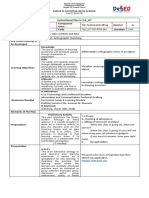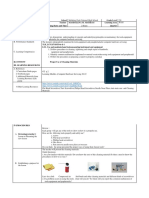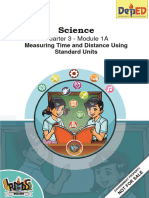Lesson 2: Performing Basic Mensuration and Calculation
Uploaded by
Rai MasamuneLesson 2: Performing Basic Mensuration and Calculation
Uploaded by
Rai MasamuneTLE-Mechanical Drafting
LESSON 2
Performing Basic Mensuration and
Calculation
INTRODUCTION
This lesson is designed to familiarize students with mensuration and
calculationan essential skill in determining shape. The shop worker preferably the
draftsman must know the exact width, height and depth of a work piece, as well as the
diameter and precise location of holes. Accuracy of measurements depends on one's
ability to use measuring tools correctly.
OBJECTIVES:
At the end of this lesson, you are expected to do the following:
LG 1. select and use measuring instruments;
LG 2. clean and store measuring instruments; and
LG 3. convert fraction to decimal and vice versa
LG 4. convert English to Metric measurement
MECHANICAL DRAFTING (EXPLORATORY GRADE 7 & 8) 27
K to 12 – Technology and Livelihood Education
What Do You Need To Know?
Read the Information Sheet very well then find out how much you
can remember and how much you learned by doing Self-check 1.1.
Information Sheet 1.1
Different Measuring Tools/instrument and their application
An understanding of measurement is essential for all parts of manufacturing and
production technology. Measurements must be uniform so that people have common
understanding and application in the production and use of manufactured objects.
Measuring tools are used for the purpose of measuring dimensions, implementing any
work with precision. The measuring tools are also used largely for carrying out different
types of measurements.
Importance of Measuring Tools
Measuring tools are essential for examining a finished product or semi- finished
product. The inspection or examination operations include checking, or testing an object
based on the required dimensions given on a diagram or a sketch. Measurements taken
must be accurate.
Different Measuring Tools
1. T-Square is used as guide in drawing horizontal lines and in measuring up to
48” straight line.
MECHANICAL DRAFTING (EXPLORATORY GRADE 7 & 8) 30
K to 12 – Technology and Livelihood Education
2. Triangles are used for drawing vertical and oblique lines. The most commonly
used triangles are the 45and the 30x 60. Illustrations below show the proper
use of drawing lines and measuring angles using the T-square and triangle.
TRIANGLE
3. Ruler is the most popular type of measuring tool. It is usually 6 or 12 inches
in length. It is needed for measuring sizes and distances.
4. Triangular Scale is used in general drawing. Its main purpose is to
reproduce the dimension in full size or to reduce or enlarge them on a drawing.
Scales help a drafter keep the proportions accurate.
MECHANICAL DRAFTING (EXPLORATORY GRADE 7 & 8) 31
K to 12 – Technology and Livelihood Education
Steps in Using a Scale
a. Place the edge of the scale parallel to the line being measured.
b. Face the edge of the scale that you're reading toward your non dominant side
(if it's oriented vertically) or away from you (if it's oriented horizontally). This
helps keep you from casting shadows on the relevant face of the scale as you
work.
c. Make light marks to indicate the distance you're measuring or drawing out, as
measured by the scale.
d. Adjust dividers with the scale by making a pencil line as long as the dividers
should be wide, using the scale as a guide. Then adjust the dividers by
orienting the points on the ends of the pencil line. Adjusting the dividers by
placing the points directly on the scale might nick the surface of the scale,
making it hard to read.
5. Protractor is used for measuring and setting of angles other than those obtainable
with the triangles.
1800
A 900
LESS THAN 900
B
STRAIGHT ANGLE RIGHT ANGLE ACUTE ANGLE
1800 900
MORE THAN 900 A
A
B B
OBTUSE ANGLE SUPPLEMENTARY COMPLEMENTARY
ANGLES ANGLES
MECHANICAL DRAFTING (EXPLORATORY GRADE 7 & 8) 32
K to 12 – Technology and Livelihood Education
6. Tape or tape ruler is a concave, spring-steel blade ranging from 1/4" to 1" wide and
6 to about 300 feet in length, coiled inside a carrying case. Metric tape ruler
comes in comparable widths and lengths up to 10 meters. It provides an easy
means for accurately measuring curved surfaces.
TAPE RULER
7. Compass is used to draw circles, arcs, radii, and parts of many symbols.
Steps in Using a Compass COMPASS
a. Place the point of the drafting compass at the center point of the circle you
intend to draw. If you're drawing an arc, imagine that the arc extends all the way
around into a circle and place the point of the compass at the center of that
imaginary circle.
b. Adjust the leaded end of the compass so that it touches where you'd like the
edge of the arc--or circle--to be. If you're drawing an arc at a specific distance
from the center point, make a line of the desired distance, adjust the point and
leaded end of the compass against the ends of that line, and then place the point
of the compass back at the center point of your circle or arc.
c. Grasp the middle of the compass between your thumb and fingers. Twist your
fingers, applying light downward pressure on the compass to mark out the
desired length of arc or circle with the leaded end of the compass.
MECHANICAL DRAFTING (EXPLORATORY GRADE 7 & 8) 33
K to 12 – Technology and Livelihood Education
How Much Have You Learned?
Self-Check 1.1
Direction: Match Column A with Column B. Write only the letter of the
correct answer on a separate sheet of paper.
Column A Column B
1. It is the measuring tool used for measuring and setting
of angles. A. Triangle
2. It is the most popular type of measuring tools, usually 6 or B. Tape Ruler
12 inches in length.
C. Protractor
3. Its main purpose is to reproduce, reduce or enlarge
the dimension or size on a drawing. D. Scale
E. Ruler
4. It is used for drawing vertical and oblique lines.
F. Divider
5. It provides an easy means for accurately measuring
curved surfaces.
Refer to the Answer Key. What is your score?
MECHANICAL DRAFTING (EXPLORATORY GRADE 7 & 8) 35
K to 12 – Technology and Livelihood Education
What You Need To KNOW?
MECHANICAL DRAFTING (EXPLORATORY GRADE 7 & 8) 37
K to 12 – Technology and Livelihood Education
1800
A 900
LESS THAN 900
B
STRAIGHT ANGLE RIGHT ANGLE ACUTE ANGLE
1800 900
MORE THAN 900 A
A
B
OBTUSE ANGLE SUPPLEMENTARY
ANGLES
MECHANICAL DRAFTING (EXPLORATORY GRADE 7 & 8)
K to 12 – Technology and Livelihood Education
You might also like
- Lesson Plan in Handicraft Production Grade 7No ratings yetLesson Plan in Handicraft Production Grade 72 pages
- Week 3-4 TLE - AS in MECHANICAL DRAFTINGNo ratings yetWeek 3-4 TLE - AS in MECHANICAL DRAFTING7 pages
- LO1 Prepare Drafting Materials and Tools Drawing InstrumentNo ratings yetLO1 Prepare Drafting Materials and Tools Drawing Instrument28 pages
- Mechanical Drafting (Exploratory) 8: Novaliches High SchoolNo ratings yetMechanical Drafting (Exploratory) 8: Novaliches High School5 pages
- Mechanical Drafting Semi - Detailed Lesson Plan (Exploratory Course)No ratings yetMechanical Drafting Semi - Detailed Lesson Plan (Exploratory Course)2 pages
- Luray Ii National High School: TLE - ICTTD7/8TD-0h1No ratings yetLuray Ii National High School: TLE - ICTTD7/8TD-0h13 pages
- Lesson 1.2 Use of Drafting Materials and ToolsNo ratings yetLesson 1.2 Use of Drafting Materials and Tools32 pages
- A Semi-Detailed Lesson Plan in T.L.E. Grade/ Section: 7-EARTH Date:, 2018No ratings yetA Semi-Detailed Lesson Plan in T.L.E. Grade/ Section: 7-EARTH Date:, 201833 pages
- K To 12 Mechanical Drafting Learning ModuleNo ratings yetK To 12 Mechanical Drafting Learning Module180 pages
- Lesson Plan in Technology Livelihood Education (DRAFTING)No ratings yetLesson Plan in Technology Livelihood Education (DRAFTING)8 pages
- Detailed - Lesson - Plan in Principles of Teaching LiezelNo ratings yetDetailed - Lesson - Plan in Principles of Teaching Liezel5 pages
- Grade 7 - 8 Technical Drafting G7or8 Slk-Module 4 MTNo ratings yetGrade 7 - 8 Technical Drafting G7or8 Slk-Module 4 MT19 pages
- Lesson Plan in T.L.E. - Exploratory DraftingNo ratings yetLesson Plan in T.L.E. - Exploratory Drafting3 pages
- Technical Drafting - G7 8 W5 LAS Analyze Signs, Symbols and DataNo ratings yetTechnical Drafting - G7 8 W5 LAS Analyze Signs, Symbols and Data13 pages
- Lesson Exemplar in T.L.E Technical Drafting 8No ratings yetLesson Exemplar in T.L.E Technical Drafting 85 pages
- LO1. Carry Out Measurements and Calculations. TLE - IACP7/8MC-0d-1 Handling of Measuring Instruments / ToolsNo ratings yetLO1. Carry Out Measurements and Calculations. TLE - IACP7/8MC-0d-1 Handling of Measuring Instruments / Tools3 pages
- October 8 & 9, 2018 (Monday & Tuesday, 10:45-11:45) : School Grade Level Teacher Learning Area Time & Dates QuarterNo ratings yetOctober 8 & 9, 2018 (Monday & Tuesday, 10:45-11:45) : School Grade Level Teacher Learning Area Time & Dates Quarter2 pages
- TLE8 - Mechanical Drafting - Q2 - Wk2 3 - Basic Mensuration and Calculation Part I FINALNo ratings yetTLE8 - Mechanical Drafting - Q2 - Wk2 3 - Basic Mensuration and Calculation Part I FINAL16 pages
- Time Day Learning Areas Learning Competency Learning Task Mode of DeliveryNo ratings yetTime Day Learning Areas Learning Competency Learning Task Mode of Delivery2 pages
- Daily Lesson Log Moreno Integrated School Grade 7 T.L.E JUNE 18-22, 2017 1 QuarterNo ratings yetDaily Lesson Log Moreno Integrated School Grade 7 T.L.E JUNE 18-22, 2017 1 Quarter19 pages
- TLE-Mechanical Drafting What Do You Need To KNOW?: A Line Drawing On A Flat Surface. From 90 DegreesNo ratings yetTLE-Mechanical Drafting What Do You Need To KNOW?: A Line Drawing On A Flat Surface. From 90 Degrees8 pages
- Republic of The Philippines Department of Education: Caraga Administrative Region Division of Agusan Del NorteNo ratings yetRepublic of The Philippines Department of Education: Caraga Administrative Region Division of Agusan Del Norte10 pages
- New Teacher of Ladies' Home Tailoring (1910) PDF100% (2)New Teacher of Ladies' Home Tailoring (1910) PDF50 pages
- CH 3 Answer Key CK-12 MSM Concepts - Grade 6 PDFNo ratings yetCH 3 Answer Key CK-12 MSM Concepts - Grade 6 PDF9 pages
- James Avery Downloadable Printable Bracelet Size GuideNo ratings yetJames Avery Downloadable Printable Bracelet Size Guide1 page
- Kids' Shoe Sizes Charts & Conversion (Baby, Toddler & Big Kids)No ratings yetKids' Shoe Sizes Charts & Conversion (Baby, Toddler & Big Kids)1 page
- MATH.5.4C MATH.5.4C MATH.5.4C Generate MATH.5.4H MATH.5.4H: Teacher Name: Grade: Subject Area: Week: Grading CycleNo ratings yetMATH.5.4C MATH.5.4C MATH.5.4C Generate MATH.5.4H MATH.5.4H: Teacher Name: Grade: Subject Area: Week: Grading Cycle5 pages
- Different Measuring Tools and Their Application0% (1)Different Measuring Tools and Their Application18 pages
- K To 12 Mechanical Drafting Learning ModuleNo ratings yetK To 12 Mechanical Drafting Learning Module181 pages
- A Detailed Lesson Plan in Tle Dressmaking 7 Use of Sewing ToolsNo ratings yetA Detailed Lesson Plan in Tle Dressmaking 7 Use of Sewing Tools15 pages
- SKL Bahasa Inggris Ujian Nasional 2008/2009: No AdminttenceNo ratings yetSKL Bahasa Inggris Ujian Nasional 2008/2009: No Adminttence22 pages
- Home Economics Individual Activity DressmakingNo ratings yetHome Economics Individual Activity Dressmaking5 pages
- LO1 Prepare Drafting Materials and Tools Drawing InstrumentLO1 Prepare Drafting Materials and Tools Drawing Instrument
- Mechanical Drafting (Exploratory) 8: Novaliches High SchoolMechanical Drafting (Exploratory) 8: Novaliches High School
- Mechanical Drafting Semi - Detailed Lesson Plan (Exploratory Course)Mechanical Drafting Semi - Detailed Lesson Plan (Exploratory Course)
- Luray Ii National High School: TLE - ICTTD7/8TD-0h1Luray Ii National High School: TLE - ICTTD7/8TD-0h1
- A Semi-Detailed Lesson Plan in T.L.E. Grade/ Section: 7-EARTH Date:, 2018A Semi-Detailed Lesson Plan in T.L.E. Grade/ Section: 7-EARTH Date:, 2018
- Lesson Plan in Technology Livelihood Education (DRAFTING)Lesson Plan in Technology Livelihood Education (DRAFTING)
- Detailed - Lesson - Plan in Principles of Teaching LiezelDetailed - Lesson - Plan in Principles of Teaching Liezel
- Grade 7 - 8 Technical Drafting G7or8 Slk-Module 4 MTGrade 7 - 8 Technical Drafting G7or8 Slk-Module 4 MT
- Technical Drafting - G7 8 W5 LAS Analyze Signs, Symbols and DataTechnical Drafting - G7 8 W5 LAS Analyze Signs, Symbols and Data
- LO1. Carry Out Measurements and Calculations. TLE - IACP7/8MC-0d-1 Handling of Measuring Instruments / ToolsLO1. Carry Out Measurements and Calculations. TLE - IACP7/8MC-0d-1 Handling of Measuring Instruments / Tools
- October 8 & 9, 2018 (Monday & Tuesday, 10:45-11:45) : School Grade Level Teacher Learning Area Time & Dates QuarterOctober 8 & 9, 2018 (Monday & Tuesday, 10:45-11:45) : School Grade Level Teacher Learning Area Time & Dates Quarter
- TLE8 - Mechanical Drafting - Q2 - Wk2 3 - Basic Mensuration and Calculation Part I FINALTLE8 - Mechanical Drafting - Q2 - Wk2 3 - Basic Mensuration and Calculation Part I FINAL
- Time Day Learning Areas Learning Competency Learning Task Mode of DeliveryTime Day Learning Areas Learning Competency Learning Task Mode of Delivery
- Daily Lesson Log Moreno Integrated School Grade 7 T.L.E JUNE 18-22, 2017 1 QuarterDaily Lesson Log Moreno Integrated School Grade 7 T.L.E JUNE 18-22, 2017 1 Quarter
- TLE-Mechanical Drafting What Do You Need To KNOW?: A Line Drawing On A Flat Surface. From 90 DegreesTLE-Mechanical Drafting What Do You Need To KNOW?: A Line Drawing On A Flat Surface. From 90 Degrees
- Republic of The Philippines Department of Education: Caraga Administrative Region Division of Agusan Del NorteRepublic of The Philippines Department of Education: Caraga Administrative Region Division of Agusan Del Norte
- James Avery Downloadable Printable Bracelet Size GuideJames Avery Downloadable Printable Bracelet Size Guide
- Kids' Shoe Sizes Charts & Conversion (Baby, Toddler & Big Kids)Kids' Shoe Sizes Charts & Conversion (Baby, Toddler & Big Kids)
- MATH.5.4C MATH.5.4C MATH.5.4C Generate MATH.5.4H MATH.5.4H: Teacher Name: Grade: Subject Area: Week: Grading CycleMATH.5.4C MATH.5.4C MATH.5.4C Generate MATH.5.4H MATH.5.4H: Teacher Name: Grade: Subject Area: Week: Grading Cycle
- A Detailed Lesson Plan in Tle Dressmaking 7 Use of Sewing ToolsA Detailed Lesson Plan in Tle Dressmaking 7 Use of Sewing Tools
- SKL Bahasa Inggris Ujian Nasional 2008/2009: No AdminttenceSKL Bahasa Inggris Ujian Nasional 2008/2009: No Adminttence




































































































